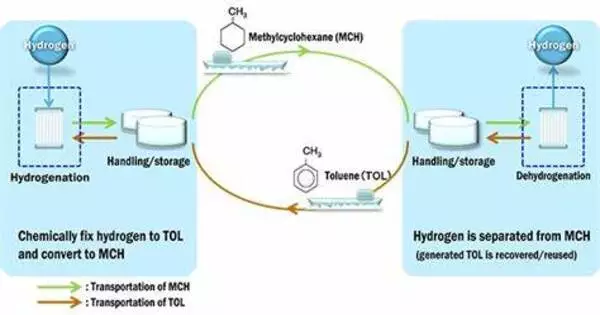Hydrogen is gaining traction as a potential clean energy carrier for a variety of applications. One promising application is the development of a seabound hydrogen economy, in which hydrogen is produced offshore using renewable energy sources (e.g., offshore wind or wave energy) and transported to consumers or industrial hubs via ships.
A group of researchers has developed a new supply chain model that could help the global hydrogen renewable energy industry. Hydrogen has been hailed as the clean fuel of the future; it can be produced from water and emits no carbon dioxide. However, long-distance transportation is currently expensive, and no infrastructure is in place to support it.
The new supply chain model, developed by researchers in Australia, Singapore, and Germany, successfully guides the development of international hydrogen and embodied energy transportation. The full report was recently published in Energy Conversion and Management, a peer-reviewed journal.
According to the report’s lead author, Associate Professor Kaveh Khalilpour of the University of Technology Sydney (UTS), supply chain design is critical for making hydrogen economically viable.
Our model suggests that methanol shows great promise as a chemical carrier for exporting renewable energy from Australia at low costs.
Professor Iftekhar Karimi
“We studied renewable hydrogen exports from Australia to Singapore, Japan, and Germany.” Surprisingly, the analysis revealed that whether the goal is to export ‘hydrogen the atom’ or ‘hydrogen the energy’, it makes a difference. Each option results in a different supply chain system.
“As a result, a thorough understanding of the entire system is required for correct decision making,” Associate Professor Khalilpour explained. “Australia’s abundance of renewable energy resources, combined with its stable economy, means that the country can attract investments in building these green value chains in our region and even as far away as Europe.”
Establishing offshore hydrogen production facilities near renewable energy sources. To generate hydrogen from water, these facilities can use electrolysis or other hydrogen production methods powered by wind, wave, or tidal energy.

Hydrogen is expected to contribute to the diversification of Australia’s renewable energy resources beyond solar and wind power. This is regarded as critical to the country’s energy security as well as necessary for mitigating climate change.
“Hydrogen is merely an energy carrier, not a primary energy source, and thus merely a means to an end in transporting renewable energy from one location to another. The central business question in the emerging hydrogen economy is whether commodities like green hydrogen, methanol, or ammonia can be exported profitably and competitively over long distances and across oceans, bringing green energy to other parts of the world.”
“If this is true, it will have significant international energy and climate policy implications,” said Professor Reinhard Madlener of RWTH Aachen University in Germany.
“Our model suggests that methanol shows great promise as a chemical carrier for exporting renewable energy from Australia at low costs,” said Professor Iftekhar Karimi, co-lead of the project at the National University of Singapore.
Investing in R&D to advance hydrogen technologies, improve efficiency, reduce costs, and improve the overall performance of the seabound hydrogen supply chain. Conducting comprehensive environmental impact assessments to ensure that the development of the seabound hydrogen economy is sustainable and in accordance with environmental goals.





